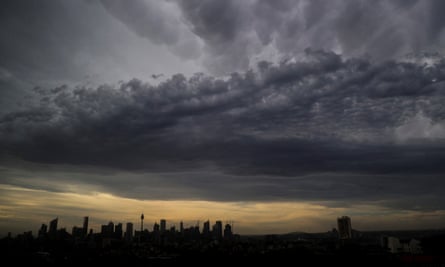Maximum heat in November was average of 2.9C above long-term mean, despite a La Niña event, which typically brings cooler patterns

|
|
Clouds over Sydney’s skyline as a cool change moves in after two
successive days of temperatures above 40C. Australia broke
numerous records for heat in spring 2020, despite the La Niña
climate event. Photograph: Jenny Evans/Getty Images |
Australia has sweltered through its hottest spring and November on record, with both the season and the month more than 2C (3.6F) warmer than the long-term average.
Temperatures in spring were 2.03C hotter than average across night and day. In November, they were 2.47C above the long-term mean, which is measured across the years 1961-90.
Maximum heat in November went even further beyond what Australians are used to, on average reaching 2.9C above the historic mark. The previous record average was 2.4C above the long-term mark, set in November 2014.
Large areas in the east and south-east experienced maximums more than 10C above average on a number of days late in the month, with many weather stations in New South Wales breaking their record for the hottest day and night on 28 or 29 November.

|
|
Australian spring mean temperature anomaly
(1910-2020). Illustration: Bureau of Meteorology
|
Dr Andrew Watkins, the bureau’s head of climate operations, said the record-breaking temperatures were particularly remarkable as they had been recorded during a La Niña, a climate event in the Pacific Ocean that typically brings cooler and wetter weather.
“As a climatologist, it is really not what you would expect during a La Niña,” he said.
Watkins said the heat spike in November could partly be explained by the La Niña temporarily weakening, tropical rainfall patterns being “stuck” in the Atlantic and Indian Oceans and a weakening of the southern annular mode, which moved weather systems northwards. Together, they reduced cloud cover and contributed to higher air pressure and lower rainfall than expected during a La Niña.
These changes occurred against a backdrop of climate change. Australia has on average warmed by 1.44C since 1910, and a La Niña year was now as warm as an El Niño year was in the last century, Watkins said.
The records in the most recent climate data include new highs for minimum night-time temperatures across the continent: 1.91C above average for spring and 2.04C for November.
The extraordinary heat last weekend broke heat records for November in South Australia, Victoria and NSW. Smithville, in north-west NSW, reached 46.9C, Andamooka, in the far north of South Australia, hit 48C and Ouyen in Victoria equalled the previous high for the month of 45.8C.
The only national measurement not to set a new record was for the average maximum temperatures in spring. It was the fifth hottest recorded, 2.15C above the long-term benchmark.
 |
Australian November mean temperature anomaly (1910-2020). Photograph: BOM |
Temperatures in Western Australia in November were also an exception. The average maximum temperature in the state’s south-west was cooler than average.
Rainfall in spring was slightly below average across much of the continent, though not as low as the incredibly dry spring last year, which set the scene for the worst bushfires on record over spring and summer.
Total rainfall was 8% below average, and notably down in significant parts of Queensland, north-east NSW and western Tasmania. It was above average in the Kimberley and Pilbara in Western Australia, much of South Australia, western NSW and far south-west Queensland.
Despite the extreme heat in spring, Watkins said summer was expected to be more benign on average than the past couple of years. A strengthened La Niña was likely to bring warm muggy nights and increase the likelihood of tropical cyclones, but daytime temperatures were likely to be lower than last summer, he said.
Links
- Rising levels of carbon dioxide increasing extreme weather events in Australia, report finds
- Bushfire threatens Sydney homes after city swelters through hottest November night on record
- (AU) Bureau Of Meteorology Says The NT Experienced Its Hottest November In 100 Years
- Sydney Records Hottest November Night As Heatwave Sweeps City
- Rising Temperatures Will Cause More Deaths Than All Infectious Diseases – Study
- (AU) Trend Towards Worsening Heatwaves Is Accelerating, New Research Finds
- (AU) Just How Hot Will It Get This Century? Latest Climate Models Suggest It Could Be Worse Than We Thought

No comments :
Post a Comment